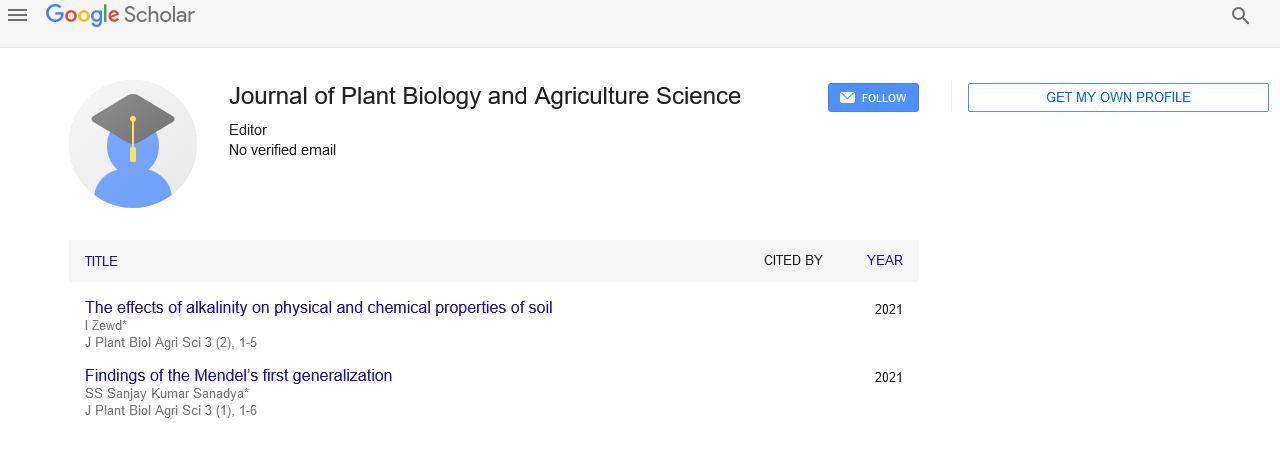Crop yield in agriculture
Received: 09-Jul-2022, Manuscript No. puljpbas-22-5705; Editor assigned: 11-Jul-2022, Pre QC No. puljpbas-22-5705(PQ); Accepted Date: Aug 06, 2022; Reviewed: 22-Jul-2022 QC No. puljpbas -22-5705(Q); Revised: 31-Jul-2022, Manuscript No. puljpbas-22-5705(R); Published: 08-Aug-2022, DOI: 10.37532/puljpbas.2022.4(4).1-2
Citation: Putin A. Crop yield in agriculture J Plant Biol Agric Sci. 2022;4(4):1-2.
This open-access article is distributed under the terms of the Creative Commons Attribution Non-Commercial License (CC BY-NC) (http://creativecommons.org/licenses/by-nc/4.0/), which permits reuse, distribution and reproduction of the article, provided that the original work is properly cited and the reuse is restricted to noncommercial purposes. For commercial reuse, contact reprints@pulsus.com
Abstract
The term "surrender" in the context of agriculture refers to an estimate of the cost of an edit produced, or of an item produced, such as fleece, meat, or drain, per region of arrival. An additional method of determining yields is the seed proportion. Increased yields have resulted from innovations such as the use of fertilizer, the development of better cultivating tools, contemporary cultivation techniques, and advanced trim assortments. The efficiency and benefit of a farm increase along with the surrender and serious use of the farmland, which improves the well-being of farming families.
Introduction
Crops that are too much for subsistence farming can be traded or sold. More draught animals, like steeds and bulls, can be strengthened and saddled for work and faeces production the more grain or grain a farmer can produce. Additionally, increased trim yields suggest that less workers are needed on the farm, freeing them up for business and industry. This in turn led to the layout and growth of cities, which at that time translated into a rise in the demand for food.
quantification
Nowadays, kilos per hectare or bushels per acre are the standard units used to measure a trim's productivity. Long-term cereal yields in the United Kingdom ranged from a few hundred kilograms per hectare in the Middle Ages to 2000 kg per hectare during the Industrial Revolution, and then again to 8000 kg per hectare during the Green Revolution. Each new invention that increases the trim surrender also reduces the ecological footprint of society. Although they are connected, yields and agrarian efficiency are not the same. While yields are determined by the weight of the crop produced per unit of land, rural efficiency is determined by the amount of money supplied per unit of arrival. Ranchers can spend a significant amount of money to increase their yields by a significant amount, such as by using extremely expensive fertilizer, but if the cost is too high and does not provide a comparable return on investment, their profits will decline. In this situation, a higher abdication will result in a lower agricultural efficiency proportion. For instance, if three grains are harvested for every grain seeded, the resulting seed percentage is thought by some agronomists to be the bare minimum necessary to maintain human life. The remaining two seeds must either be consumed by the cultivator or used as animal feed. One of the three seeds must be kept away for the upcoming planting season. When the three-field trim structure was introduced in the Moo Nations around the 14th century, the seed proportion there increased to 1:14 from just 1:2.5 in some regions of Europe around the ninth century
agribusiness
The business of raising plants and animals is known as agribusiness. The cultivation of domesticated species produced food surpluses that allowed people to dwell in cities, and this was the crucial development in the creation of stationary human civilization. Horticulture has a long and illustrious history dating back thousands of years. Early ranchers began to sow wild grains around 11,500 years ago after first harvesting them starting at least 105,000 years earlier. 10,000 years ago, pigs, sheep, and cattle were domesticated. In at least 11 areas around the world, plants could be grown without restriction. In the 20th century, 2 billion people continued to depend on subsistence gardening, but mechanical horticulture based on massive monoculture started to take over agrarian output. Foods, threads, fillers, and raw materials can be generically categorized as the core rural goods (such as elastic). The nutrition lessons include a wide range of topics, including grains (cereals), vegetables, organic foods, oils, meat, dairy products, eggs, and parasites. Despite the fact that over one-third of the world's workers are employed in the agribusiness sector, second only to the profit sector, the global trend of fewer agrarian workers is continuing, especially in developing countries where smallholding is being replaced by mechanical horticulture and mechanization that results in a significant edit abdicate increase. Edit yields have significantly increased with to modern agronomy, plant breeding, agrochemicals such pesticides and fertilizers, and technological innovations, but at the cost of biological and environmental damage. The yield of meat has increased as a result of selective breeding and cutting-edge advances in creature cultivation, but these developments have also prompted questions about the wellbeing of the creatures and environmental harm.





